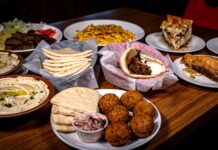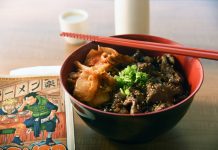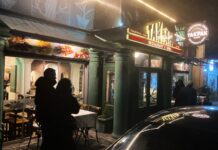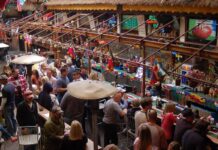“I wonder how many people I’ve looked at all my life and never seen.”
― John Steinbeck, The Winter of Our Discontent
The random space alien descending to our small, bluegrass-laden expanse of the planet might well be confused. Why (on earth) are these humanoids tearing each other to shreds over ephemera even as a destructive virus has yet to express a clear preference when it comes to one’s choice of political affiliation?
Consequently today’s three-course menu omits both appetizer and dessert, instead offering the reader a trio of full entrees, beginning with Chef Edward Lee’s candid conversation with Ashlea Halpern at Bon Appétit: I’m Afraid It’s Too Late to Save Restaurants. Lee’s personal Instagram account introduced the link with these words.
Most days, I can muster up enough positivity to get through the bleak days and nights that seem like an endless string of uncertainty. The day I did this interview, I was just exhausted. And dejected. I truly hope I’m wrong about everything I say in this interview but so far we are heading this way. And no relief in sight.
An excerpt can’t do justice to the emotional eloquence of Lee’s thoughts: “There’s a huge feeling of abandonment. You devote your life to the restaurant business, you pay your taxes, and then you realize there’s no help coming from anywhere.”
It’s heartbreaking to watch dedicated young men and women who’ve honed a craft and made this beautiful thing we call ‘the restaurant renaissance,’ which brought pride and global attention to ‘American cuisine’ and two decades ago didn’t even exist, you know…making $8 cheeseburgers to-go just to make payroll.
But that’s where we’re at. Yet you drive by the local McDonald’s and there are 20 cars lined up for drive-through. It breaks your heart to see that, and to know that by the time all of the independent restaurants go away, it’ll be too late. The customers will say, ‘What a shame.’ The chance to save them is right now.
Next, a masterful editorial by Jeremy Repanich at The Robb Report, which was published on November 18. These words are served whole, sans mincing:
“What could government even do?” you may ask with your hands thrown up in the air. Lack of action at this moment should not be shrugged off as everyday partisan gridlock. Don’t let politicians off that easy; don’t expect so little of them. The government has made an active decision to let independent restaurants, one of the nation’s largest employers, die.
Congress and the president have the power to intervene with aid—in fact, the House has already passed a second round of stimulus with $120 billion earmarked specifically for restaurants—but they have chosen not to. The Senate doesn’t want to vote on the bill, because it doesn’t want to make that choice explicit. So all restaurateurs can do is chafe against governors, mayors and county commissioners who tell them to stop operating for the benefit of public health, even as large swaths of the American public have shown little interest in protecting their own health—or that of their neighbors.
Bipartisan political turpitude consequently pushes restaurateurs into self-abnegation.
Independent restaurateurs need dining on premise to survive. That puts them in the uncomfortable position of having to fight against the very science that the most well-meaning among them pledge so much fealty to. They may sport “In Fauci We Trust” T-shirts when Dr. Anthony Fauci recommends that everyone wear masks, but are less willing to listen to him when he suggests on national TV that indoor dining should be halted because it carries a high-risk profile.
Case in point: On (November 17), the National Restaurant Association sent a letter telling governors to not make restaurants the scapegoats for the current Covid-19 surge. In the letter, the organization states that there’s no scientific evidence tying restaurants to rising infections, while also making the fallacious argument that restaurants are just like other retail establishments and should be treated as such. Yes, private gatherings are a driver of the surge in cases, but that doesn’t mean that indoor dining doesn’t pose a threat to public health as well.
These arguments fly in the face of the coalescing scientific consensus that this disease is airborne and sitting unmasked in an enclosed space helps spread the virus—a point driven home by the data visualizations published by the Spanish newspaper El País. So for the National Restaurant Association to say that a restaurant is no different than a retail shop denies the obvious fact that you don’t sit in a store maskless in conversation for a few hours like you do dining indoors.
To be sure, indoor dining should be curbed. Unfortunately, the people handing down those strictures have thrown away their credibility…
We’re here because we weren’t, there.
There was a straightforward answer to this problem early on. We did not want to face it, because it seems so anathema to how we view work and the role of the government in the market. We should have paid everyone to stay home for six weeks and put the economy on ice. We tried to keep the wheels turning too much. Sure, a group of us stayed home, but others—like restaurants and their staffs—were forced to go out and expose themselves so they could survive. The virus would not been able to get a foothold like it did had we had been more aggressive early. But paying people not to work runs so counter to America’s self image that we couldn’t wrap our brains around it. Even restaurateurs scoffed at having to spend the forgivable PPP loans on paying employees, because they didn’t have enough for them to do at the time. Now, instead of being ahead of the virus, we keep finding ourselves a step slow. And with a lack of aid to help them catch up, restaurants keep falling even further behind.
On Friday morning the daily New York Times e-newsletter included this handy summary by David Leonhardt: “Good morning. It’s going to be a long, hard winter. We offer a three-step guide to living safely.”
Human beings are social creatures. Most aren’t going to sit inside their houses for months on end. And pretending otherwise tends to backfire. It leads people to ignore public health advice and take needlessly big risks. “We need different, more nuanced, and more practical messaging about coronavirus safety,” Sarit Golub, a psychology professor at Hunter College, has written.
(Federal officials took a step in this direction this week by shortening the recommended quarantine period after virus exposure.)
Today, I want to give you a three-step guide to risk minimization. It’s based on a Times survey of 700 epidemiologists as well as my conversations with experts and colleagues, like Donald G. McNeil Jr.
1. There is one behavior you should try to eliminate, without exception: Spending time in a confined space (outside your household) where anyone is unmasked.
Don’t eat indoors at a restaurant or friend’s house. Don’t have close, unmasked conversations anywhere, even outdoors. If you must fly, try to not to eat or drink on the plane. If you’re going to work, don’t have lunch in the same room as colleagues. Group lunches have led to outbreaks at hospitals and elsewhere.
2. This next set of behaviors is best to minimize if you can’t avoid it: Spending extended time in indoor spaces, even with universal masking.
Masks aren’t perfect. If you can work out at home rather than at a gym — or do your job or attend religious services remotely — you’re reducing your risk.
3. Now the better news: Several activities are less risky than some people fear.
You don’t need to wear a mask when you go for a walk or a jog. Donald, who’s famously careful, bikes without a mask. “I consider keeping six feet distant outdoors more important than wearing a mask,” he told me. “If I had a birthday candle in my hand and you’re too far away to blow it out, I can’t inhale whatever you exhale.”
You can also feel OK about doing many errands. About 90 percent of the epidemiologists in our survey have recently visited a grocery store, a pharmacy or another store. Just wear a mask, stay distant from others and wash your hands afterward.
The big picture: I find it helpful to think about the notion of a personal risk budget. I don’t spend any of my risk budget on supermarket shopping, because grocery delivery works well for my family. But I do take occasional unmasked, distant walks with one or two friends. They help keep me sane as we head into a long, very hard winter.
For more: The survey of epidemiologists — done by Margot Sanger-Katz, Claire Cain Miller and Quoctrung Bui of The Times — has much more, including how they’re thinking about a vaccine.
Back in March, United Nations Secretary-General António Guterres addressed the planet, saying, “This is a time for prudence, not panic. Science, not stigma. Facts, not fear … we are in this together – and we will get through this, together.”
Have we?























